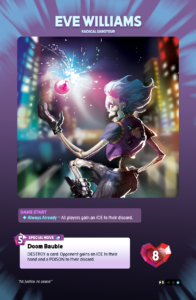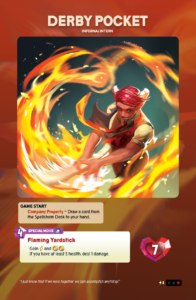Hi everyone! It’s been a few months since I wrote about Spellstorm, my new deckbuilding card game. As I wrote about a few months ago, the game took a huge turn somewhere around December, and I am so glad it did. The version of the game that I was working on before would get somewhat tepid “it’s interesting…” kinds of responses a lot of the time, and had very annoying problems that never seemed to be solvable. By contrast, this version consistently gets way more positive reactions. I notice it with my playtesters that all of us are sincerely way more excited to play.
Overall, the game has been getting tuned, especially with respect to the asymmetric characters, but a notable thing is that the basic systemic rules haven’t changed in months, and this is the first time in Spellstorm‘s 2 year development history that I can say that. So today, I want to talk about those asymmetric characters and what we’ve been trying out with them. What has worked, and what hasn’t.
Derby and Eve
Ex-Business Demon Intern Derby Pocket and radical activist skeleton Eve Williams are kind of the “original duo” of… well, the entire Gem Wizards Universe, actually. Back in 2019, when Dragon Bridge (the first game in this universe) was created for the KBgames 18 Card Strategy Jam, there were only two characters, and they were Derby Pocket and Eve Williams (here‘s a little comic I made about them, by the way). You can take a look at their (current) character cards below.


In Spellstorm, your asymmetric character has a few components. Every character has one of the above: a jumbo size character card that sets your starting (and max) hit points, any passive abilities you might have, your Special Move, and finally a description of what special components the character also has (we’ll get into that in a second). In addition to these, each character has two character abilities that get mixed into your 8 card starting deck, which are active abilities that only that character can play.
Derby and Eve are the “starting” characters, so they’re pretty simple and don’t have additional components. However, most of the other characters have at least one custom component that works in a completely different way. Some characters might have tokens they put on the board. Some might have a second character card that has a bunch of selectable upgrades on it. Some have a second deck of cards that gets dealt out as events or additional abilities. These custom components make the characters a lot more asymmetric, and it’s something I’m really excited about.
Actually, this is the really fun part that we’re in right now: coming up with cool interesting verbs that this character can do that no other character can do. That’s something that’s really important to the identity of a character. And another thing that’s important is, “what is this character bad at”. Establishing weaknesses is as important as establishing strengths. For example, Derby is kind of (as an intern), all about initiative: taking the initiative token so that their actions go first. Eve on the other hand is all about destruction, she’s kicking over sand castles, throwing bad cards at the opponent, and generally disrupting play. You might not gather all of that just from the wizard cards, but keep in mind that they do have 2 active ability cards each, AND these aren’t probably the final versions anyway.
Another couple little bits of news on characters: Bunny Wizard for awhile had his own victory condition, but we had a lot of difficulty making that work (theory suggests that it probably shouldn’t anyway), so we’re reworking him right now. And Oren Bark is our “randomness character”, who has wild random swings, but we’re thinking of how to frame that in a way that it still strategically satisfying and coherent.
I’m doing a bunch of playtesting recently on all eight characters because I want them to be as awesome as possible for the launch of the Kickstarter in a few months. We’ve got a ways to go, but I think we’re in a really good place. Thanks for reading!
You must be logged in to post a comment.